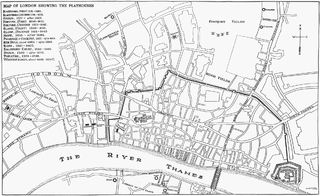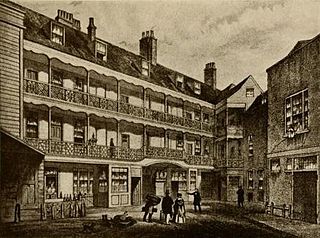This article needs additional citations for verification .(June 2015) |
| |||
|---|---|---|---|
| +... | |||
This article contains information about the literary events and publications of 1597.
This article needs additional citations for verification .(June 2015) |
| |||
|---|---|---|---|
| +... | |||
This article contains information about the literary events and publications of 1597.

The English Renaissance theatre or Elizabethan theatre was the theatre of England from 1558 to 1642. Its most prominent playwrights were William Shakespeare, Christopher Marlowe and Ben Jonson.

Richard Burbage was an English stage actor, widely considered to have been one of the most famous actors of the Globe Theatre and of his time. In addition to being a stage actor, he was also a theatre owner, entrepreneur, and painter. He was the younger brother of Cuthbert Burbage. They were both actors in drama. Burbage was a business associate and friend to William Shakespeare.
This article contains information about the literary events and publications of 1601.
This article presents lists of the literary events and publications in 1600.
This article contains information about the literary events and publications of 1596.
This article contains information about the literary events and publications of 1594.
Philip Henslowe was an Elizabethan theatrical entrepreneur and impresario. Henslowe's modern reputation rests on the survival of his diary, a primary source for information about the theatrical world of Renaissance London.
The Rose was an Elizabethan playhouse, built by theatre entrepreneur Philip Henslowe in 1587. It was the fifth public playhouse to be built in London, after the Red Lion in Whitechapel (1567), The Theatre (1576) and the Curtain (1577), both in Shoreditch, and the theatre at Newington Butts – and the first of several playhouses to be situated in Bankside, Southwark, in a liberty outside the jurisdiction of the City of London's civic authorities. Two of the earliest plays by William Shakespeare – Titus Andronicus and Henry VI, Part 1 – are recorded as having been performed there, as well as plays by dramatists such as Christopher Marlowe, Thomas Kyd, Robert Greene, George Peele, Thomas Dekker, Michael Drayton, Ben Jonson and Thomas Heywood. The Rose's archaeological remains were rediscovered in 1989 during the redevelopment of the site to build an office block, and were partially excavated. After a public campaign to preserve the remains, they are now listed by Historic England as a Scheduled Monument at Risk. Subsequently the site has become an exhibition space and theatre venue, known as The Rose Playhouse, administered by The Rose Theatre Trust, a registered charity, which plans to first complete the excavation and preservation of the remains, and then to build a new visitor, education and arts centre there.

The Swan was a theatre in Southwark, London, England, built in 1595 on top of a previously standing structure, during the first half of William Shakespeare's career. It was the fifth in the series of large public playhouses of London, after James Burbage's The Theatre (1576) and Curtain (1577), the Newington Butts Theatre and Philip Henslowe's Rose (1587–88).

The Theatre was an Elizabethan playhouse in Shoreditch, just outside the City of London. Built in 1576, after the Red Lion, it was the first permanent theatre built exclusively for the showing of theatrical productions in England, and its first successful one. Actor-manager James Burbage built it near the family home in Holywell Street. The Theatre's history includes a number of important acting troupes including the Lord Chamberlain's Men, which employed Shakespeare as actor and playwright. After a dispute with the landlord, the theatre was dismantled and the timbers used in the construction of the Globe Theatre on Bankside.
The Lord Chamberlain's Men was a company of actors, or a "playing company", for which William Shakespeare wrote during most of his career. Richard Burbage played most of the lead roles, including Hamlet, Othello, King Lear, and Macbeth. Formed at the end of a period of flux in the theatrical world of London, it had become, by 1603, one of the two leading companies of the city and was subsequently patronized by James I.

Blackfriars Theatre was the name given to two separate theatres located in the former Blackfriars Dominican priory in the City of London during the Renaissance. The first theatre began as a venue for the Children of the Chapel Royal, child actors associated with the Queen's chapel choirs, and who from 1576 to 1584 staged plays in the vast hall of the former monastery. The second theatre dates from the purchase of the upper part of the priory and another building by James Burbage in 1596, which included the Parliament Chamber on the upper floor that was converted into the playhouse. The Children of the Chapel played in the theatre beginning in the autumn of 1600 until the King's Men took over in 1608. They successfully used it as their winter playhouse until all the theatres were closed in 1642 when the English Civil War began. In 1666, the entire area was destroyed in the Great Fire of London.
In Renaissance-era London, playing company was the usual term for a company of actors. These companies were organised around a group of ten or so shareholders, who performed in the plays but were also responsible for management. The sharers employed "hired men" – that is, the minor actors and the workers behind the scenes. The major companies were based at specific theatres in London; the most successful of them, William Shakespeare's company the King's Men, had the open-air Globe Theatre for summer seasons and the enclosed Blackfriars Theatre in the winters. The Admiral's Men occupied the Rose Theatre in the 1590s, and the Fortune Theatre in the early 17th century.

George Carey, 2nd Baron Hunsdon KG was the eldest son of Henry Carey, 1st Baron Hunsdon and Anne Morgan. His father was first cousin to Elizabeth I of England. In 1560, at the age of 13, George matriculated at Trinity College, Cambridge.

John Lowin was an English actor.
The Admiral's Men was a playing company or troupe of actors in the Elizabethan and Stuart eras. It is generally considered the second most important acting troupe of English Renaissance theatre.
Lord Strange's Men was an Elizabethan playing company, comprising retainers of the household of Ferdinando Stanley, Lord Strange. They are best known in their final phase of activity in the late 1580s and early 1590s. After 25 September 1593, they were known as the Earl of Derby's Men, that being the date of Stanley's accession to his father's title.
The Lady Elizabeth's Men, or Princess Elizabeth's Men, was a company of actors in Jacobean London, formed under the patronage of King James I's daughter Princess Elizabeth. From 1618 on, the company was called The Queen of Bohemia's Men, after Elizabeth and her husband the Elector Palatine had their brief and disastrous flirtation with the crown of Bohemia.
Francis Langley (1548–1602) was a theatre builder and theatrical producer in Elizabethan era London. After James Burbage and Philip Henslowe, Langley was the third significant entrepreneurial figure active at the height of the development of English Renaissance theatre.

In the historical era of English Renaissance drama, an Inn-yard theatre or Inn-theatre was a common inn with an inner courtyard with balconies that provided a venue for the presentation of stage plays.